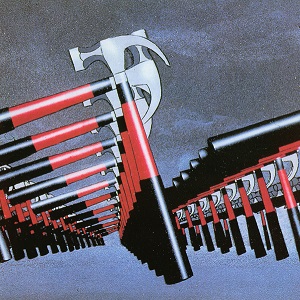The late 1970s were a fertile period for LP shoppers. Many rock artists were in a groove to release one new album each year. New record stores popped up frequently in Miami, eager to push the burgeoning catalogs of popular artists. I remember visiting a new store (forgot the name - was it Music Makers?), which didn't last too long, but I found Caravan to Midnight by Robin Trower as I browsed. I knew who/what Robin Trower was - a guitarist and a group! I remember hearing a lot of his music from the early 1970s - classic albums such as Twice Removed from Yesterday (1972) and Bridge of Sighs (1974), but I realized that I didn't actually own any Robin Trower records. So I bought Caravan to Midnight on the spot to fill that embarrassing hole in my collection.
I was pleasantly surprised to find the original band pretty much intact. Bill Lordan from Sly & The Family Stone had replaced the first drummer, Reg Isadore, beginning with For Earth Below (1975), but vocalist/bassist James Dewar remained. However, Louisiana native Rustee Allen (aka Rusty Stone, also a former member of Sly & The Family Stone) was the bassist on Caravan.
I'm still puzzled why Robin Trower (the group) was rarely mentioned when critics wrote about power trios of the day like The Jimi Hendrix Experience, Rush, and Cream. Maybe the lack of gimmicks explains the lack of recognition. For three players without synthesizers, background vocalists, or dubbed in horn sections, Robin Trower sure filled a lot of the available ear space. Trower's guitar lines are loaded with authority, whether he's soloing or just riffing, and the rhythm players and vocals are as good as they get.
Speaking of vocals, I've read reviews that place Dewar in the top echelon of blues-rock singers, and I wouldn't argue against that claim. His phrasing always seems to hit the spot and gives lyrics, no matter how mundane, a depth that most blues-rock vocalists don't match. However, comparing Dewar to blues artists like Buddy Guy, Muddy Waters, John Lee Hooker, and B.B. King might be a bit of a stretch, not to mention the dozens of R&B/soul singers over the past 70 years. Yes, Dewar sings better than Stevie Ray Vaughan, but not as good as Otis Redding or Sam Cooke.
A key track on Caravan to Midnight is the title piece, a 5-minute instrumental featuring Trower's sustained chords on a mid-tempo burn. It reminds me a little of David Gilmour's song "Raise My Rent" off of his 1978 solo album. For fans of straight-ahead rock, the first track, "My Love (Burning Love)" offers a satisfying taste of Trower comping behind Dewar's raw vocals. Caravan to Midnight also includes two atypical songs: "Lost in Love" and "Birthday Boy." These are both sweet and sincere, and they break up the program nicely.
My favorite tracks are "I'm Out to Get You," "Fool," "King of the Dance" - a nod to disco - and the closing "Sail On." Perhaps it's due to repeated listening over a period of 45 years, but these songs all sound perfect to me. They cover the range of styles in the group's comfort zone while moving away from earlier formulas such as the epic "Bridge of Signs/In This Place" sequence from Bridge of Signs and the hard rock of "Hannah" and "Rock Me Baby" from Twice Removed from Yesterday. Don't get me wrong, I dig the earlier albums a lot, but it's the new versatility of the band that makes Caravan to Midnight special.
Trower continues to record. His most recent album I know of is No More Worlds to Conquer, released in 2022, and the chops are still there. As a fellow "senior citizen," just six months older than Trower, I can understand why his creative powers could be sustained past age 75. A 60-year recording career serves as a deep well of experience that can be drawn from when needed.
Steve:
I agree with Dan's assessment that Robin Trower has received less substantive regard than befits an artist of his stature. I say "substantive" because although he is a well-regarded artist, the achievements for which he is given credit are mostly reduced to something like, "he took the baton from Jimi Hendrix circa Electric Ladyland, took it to the bank, and has been milking that ever since". While this may be true of his early albums (i.e., before any "milking" accusations would even be appropriate), Trower is rarely given credit for the stylistic growth arc I can see on his 70s albums. Far from "making the same album over and over again", Trower established his thesis on the first album (Twice Removed from Yesterday), perfected the style on his second (Bridge of Sighs), repeated himself on his third (the still fine For Earth Below), tinkered with the formula by adding soul and funk on his fourth (Long Misty Days), made a failed attempt at a new style on his fifth (the tentative In City Dreams), and corrected that album's mistakes for a shiny new look for his sixth (Caravan to Midnight).
Caravan uses Trower's unique guitar style and sound as an identifying stamp on the songs, but the songs themselves are not based around or otherwise dependent on that sound. Songs such as "Fool", "It's for You", or "My Love (Burning Love)" could proudly stand as highlights on the albums of any number of artists; the songs are well written, thoughtfully arranged, and convey real emotion. Singer James Dewar, who co-wrote all but one of the tracks with Trower, deserves a lot of the credit for making these songs as strong and convincing as they are.
Dan clearly enjoyed this album a lot when I was a kid, as I recall it playing in the house frequently, particularly side 2, which kicks off with my favorite tune, "Fool". With their new self-assured style, diversity rules the day, as the middle of side 2 features two very unusual songs for Trower: "Birthday Boy" and "King of the Dance". The first of these is a ballad with a very striking production style: Dewar's vocals have an eerie ring-modulated effect, giving them a sad and alienated feel as he weeps through the high notes in the cathartic chorus. The latter ("King of the Dance") is its polar opposite, a triumphant romp with a danceable beat, as Dewar roars happily and Trower has fun with his wah-wah pedal.
Trower would mostly return to basics on his subsequent albums, but the gains he made on Caravan to Midnight would continue to give his work the same depth and diversity that make this one of his best achievements.



























